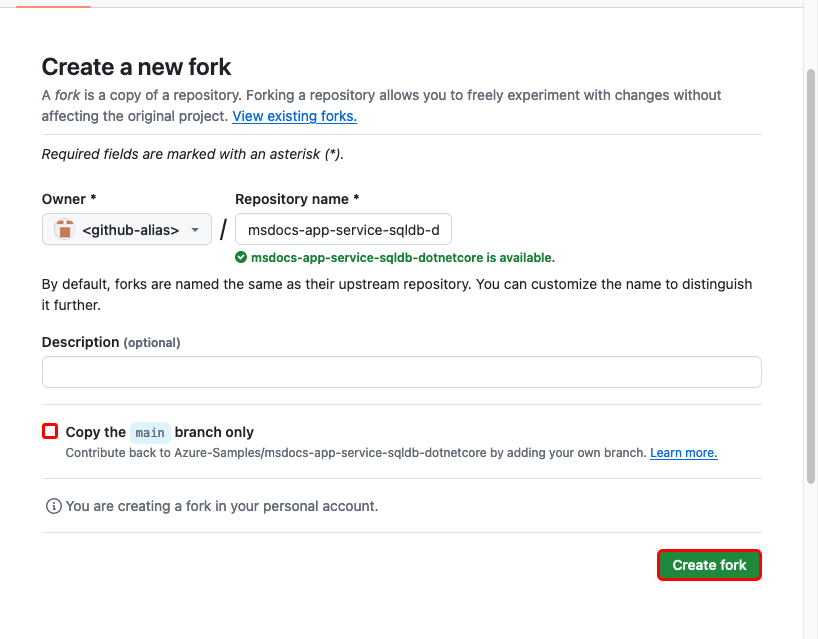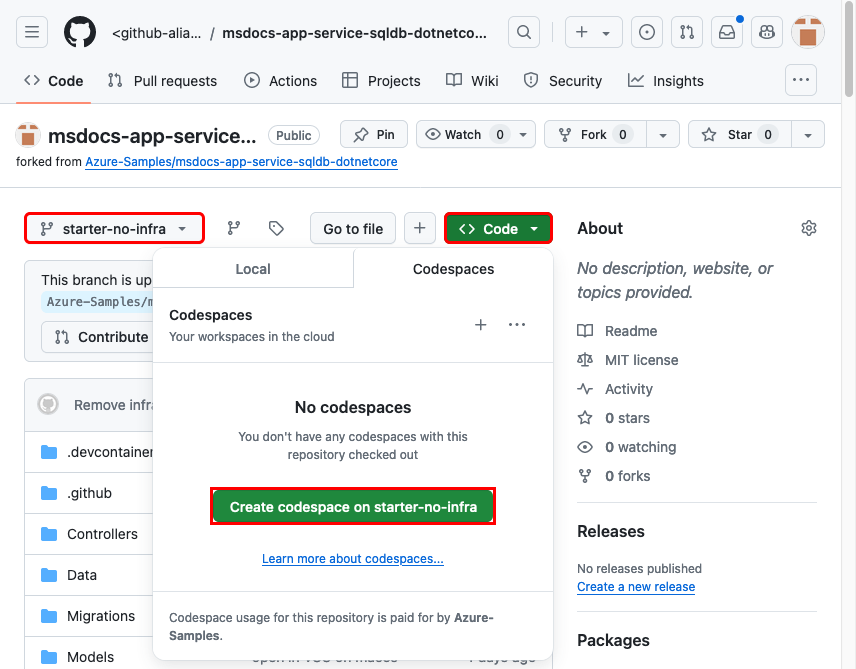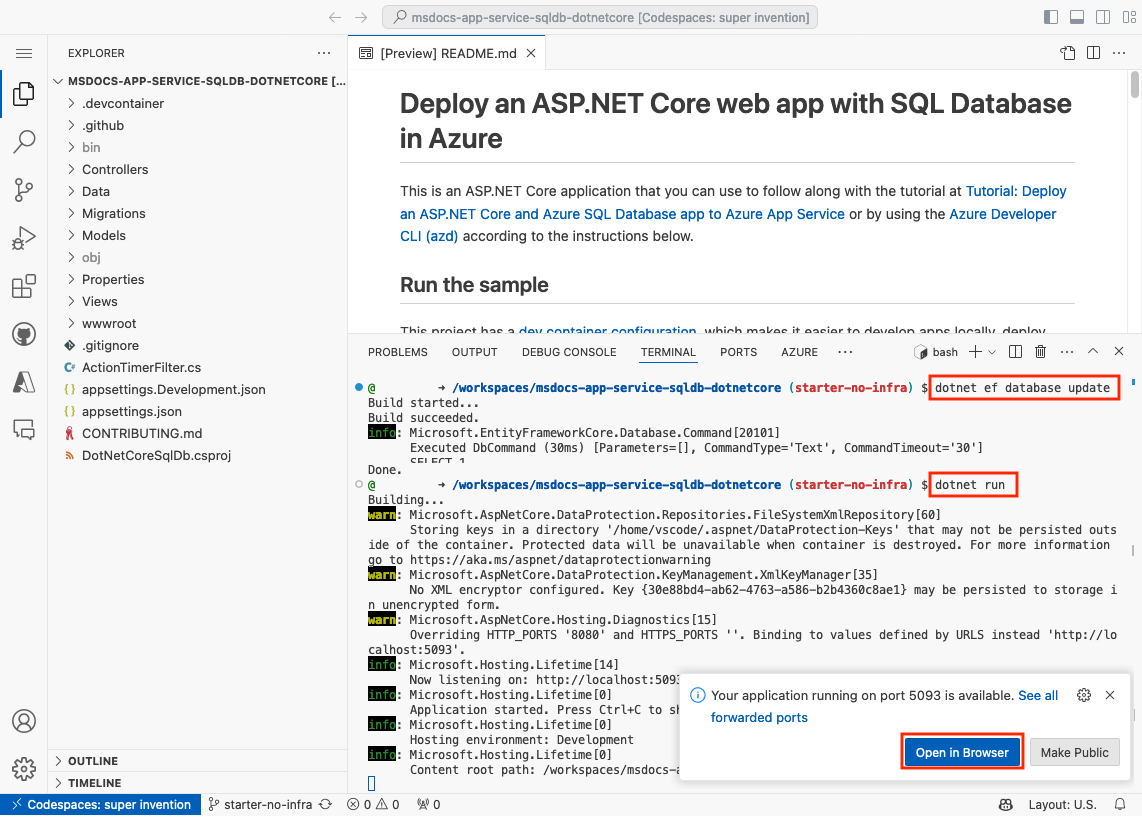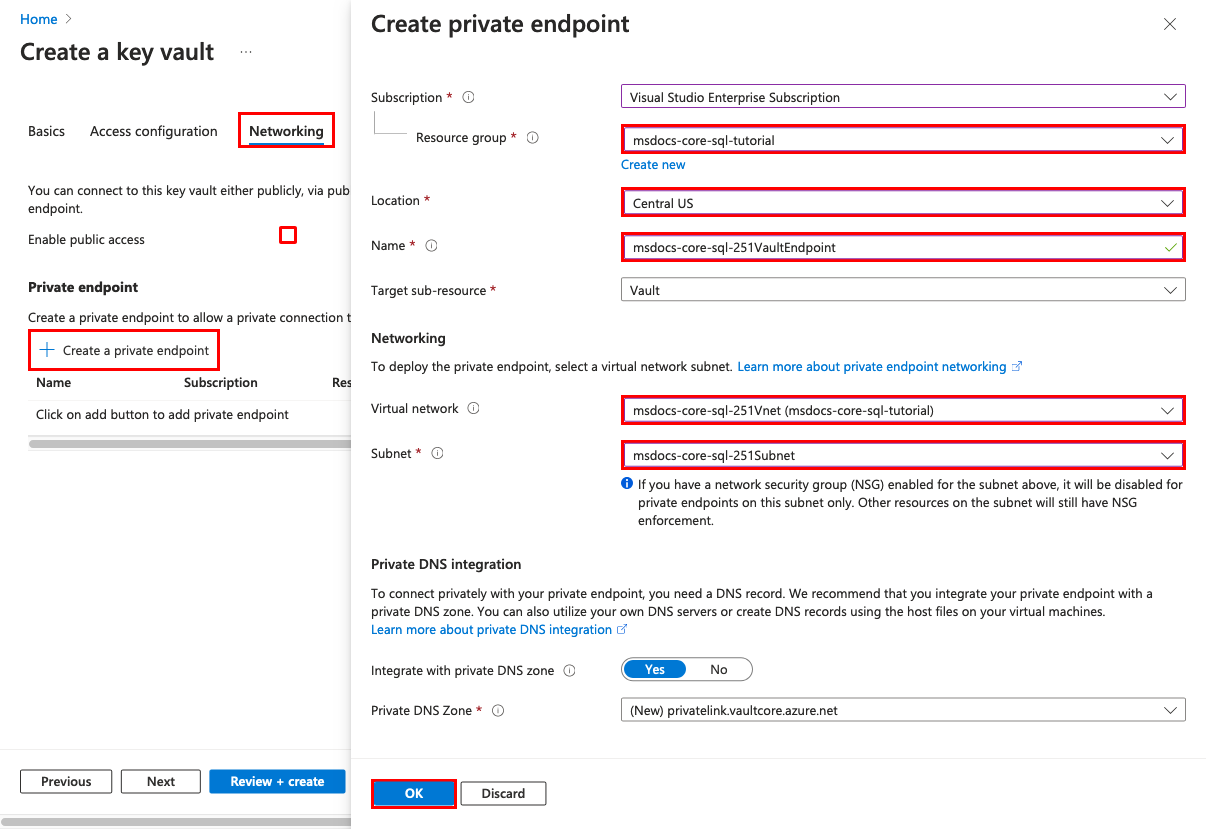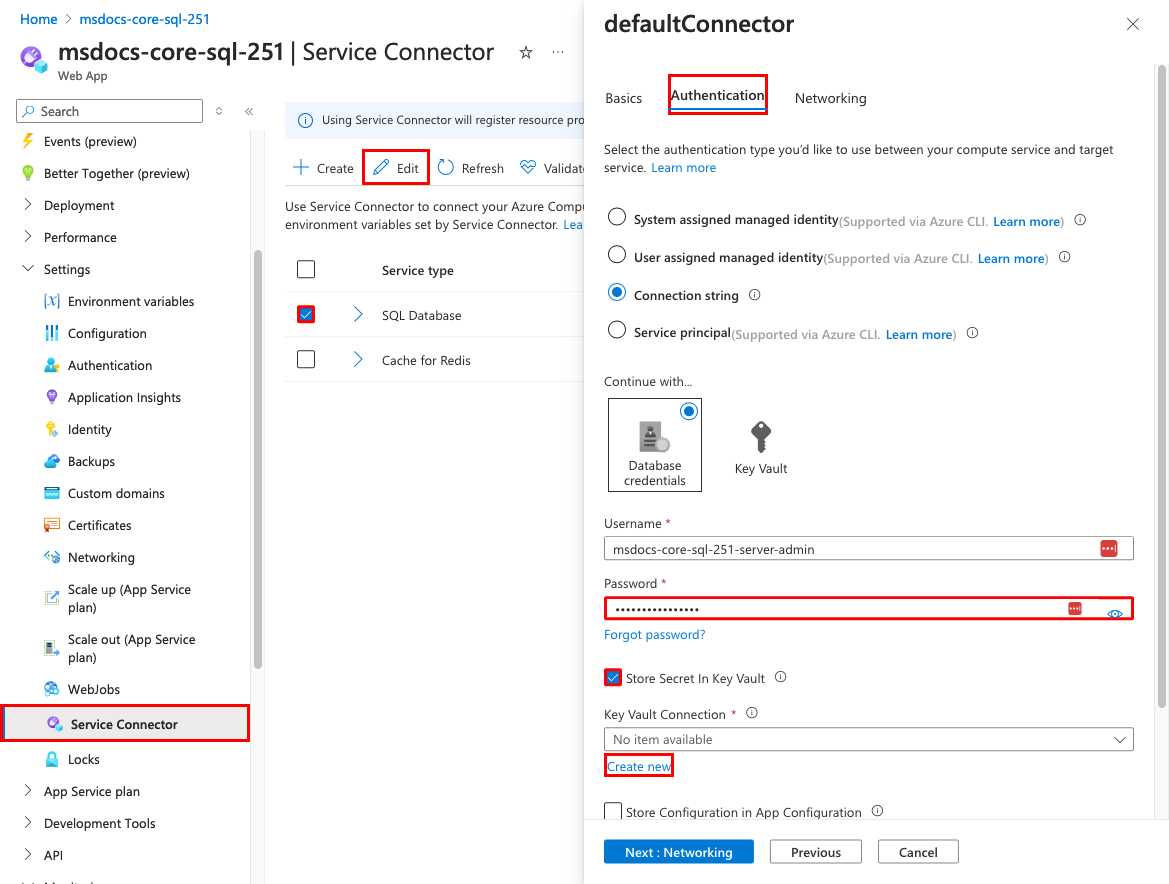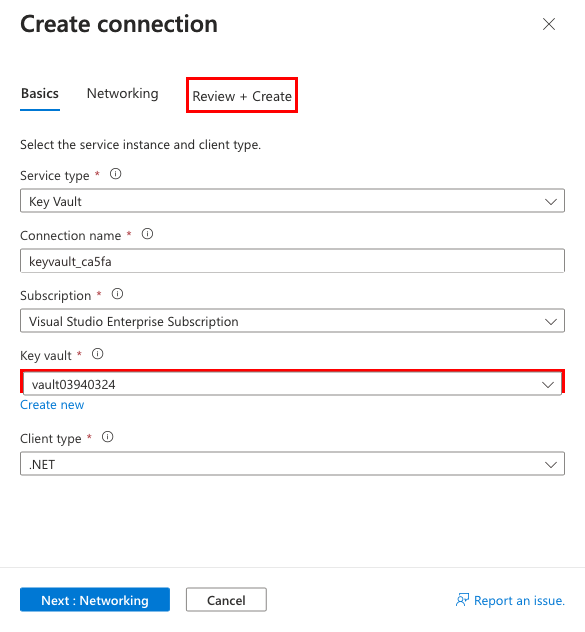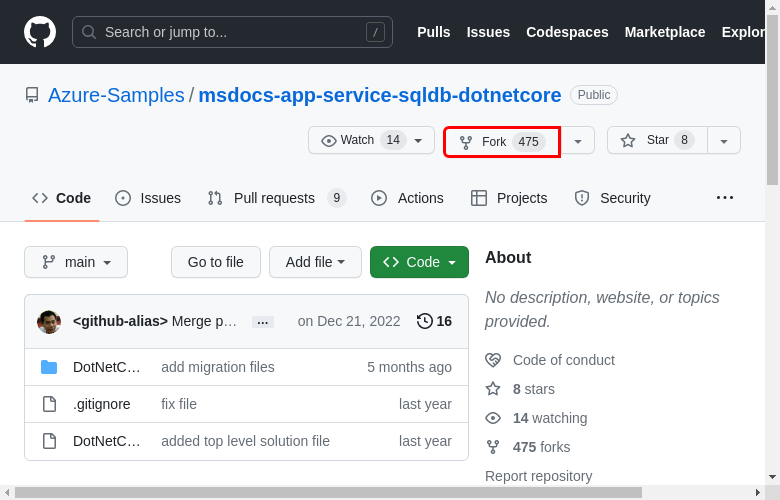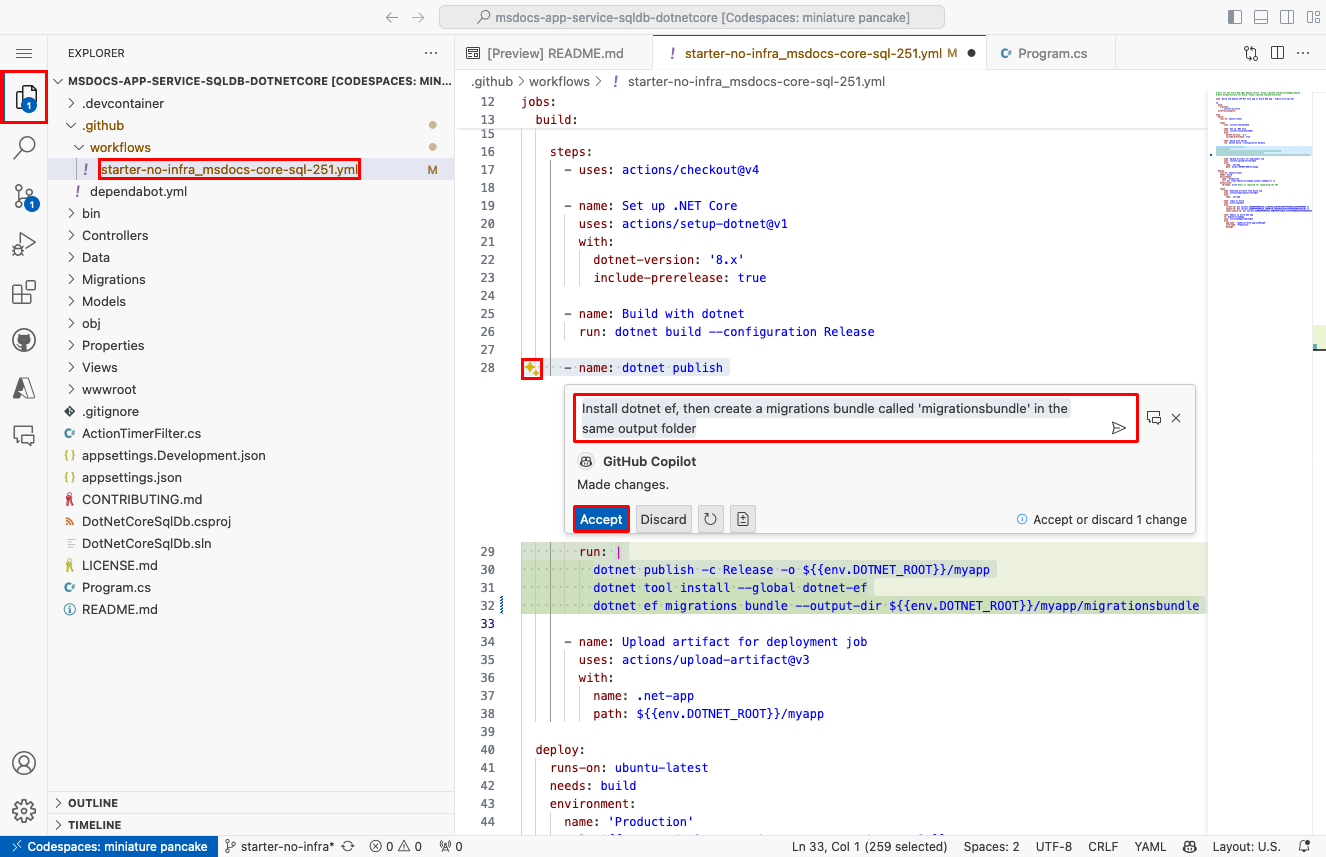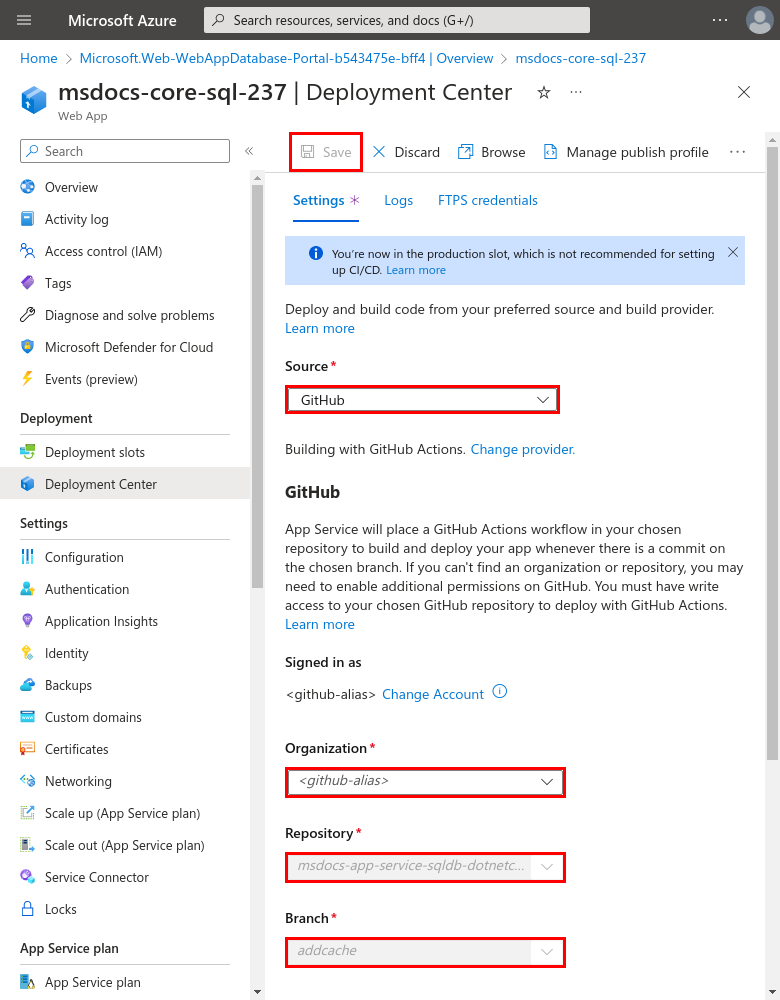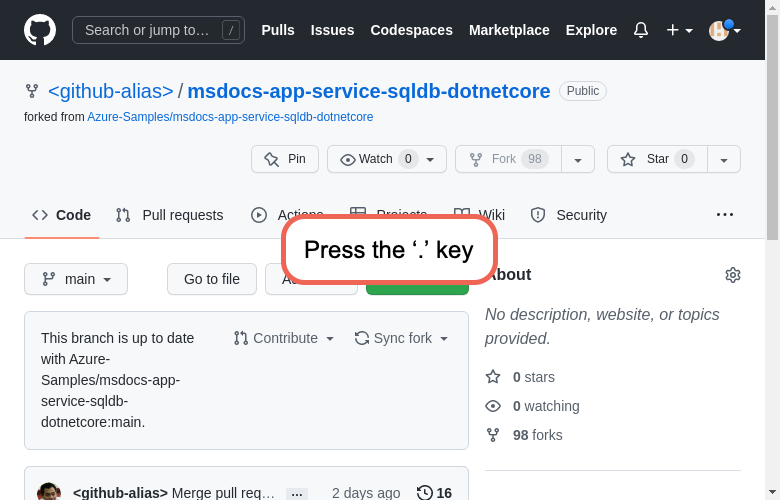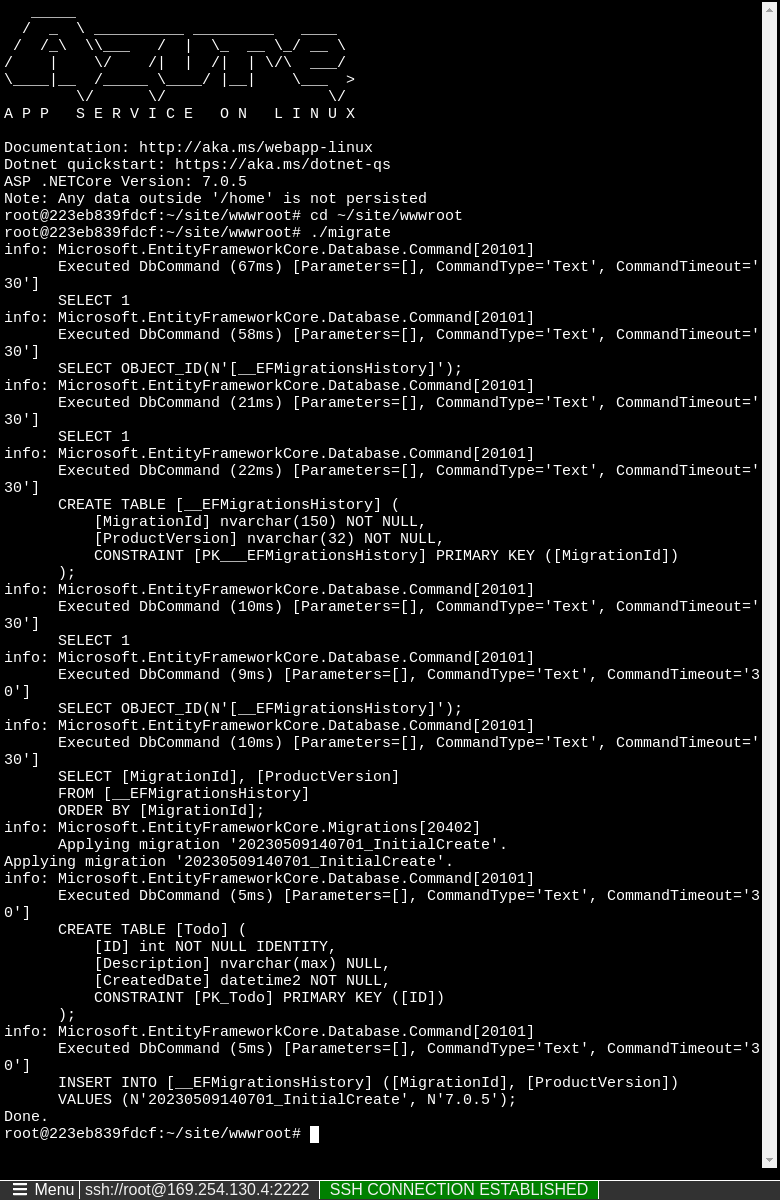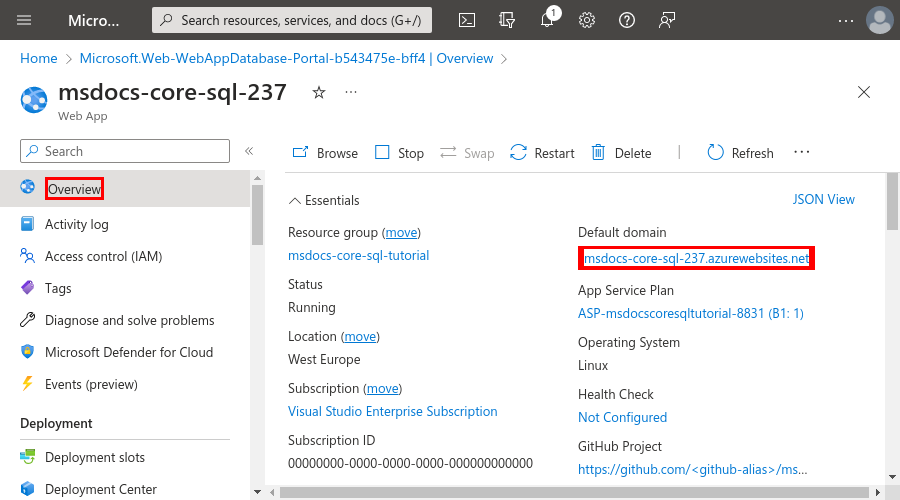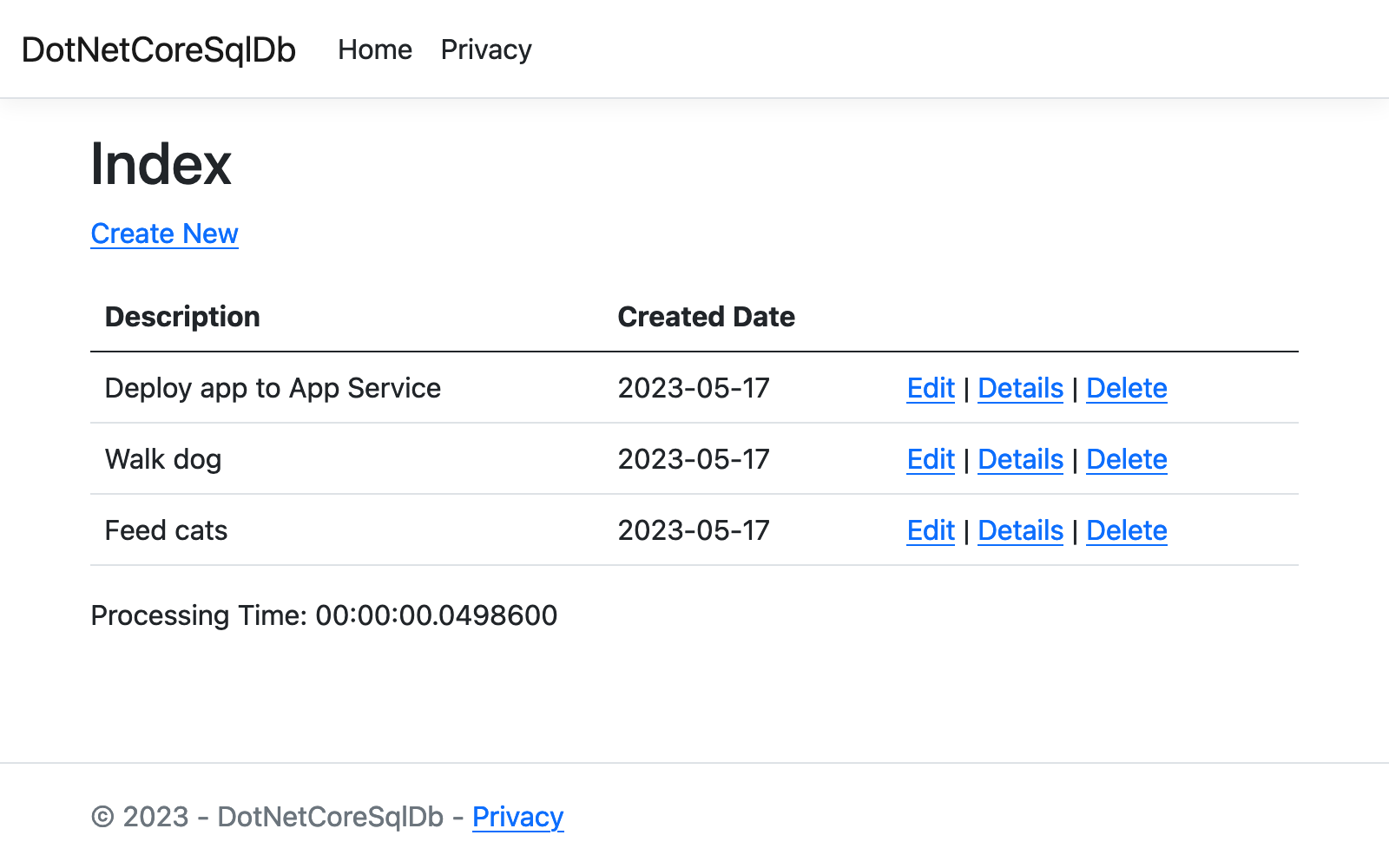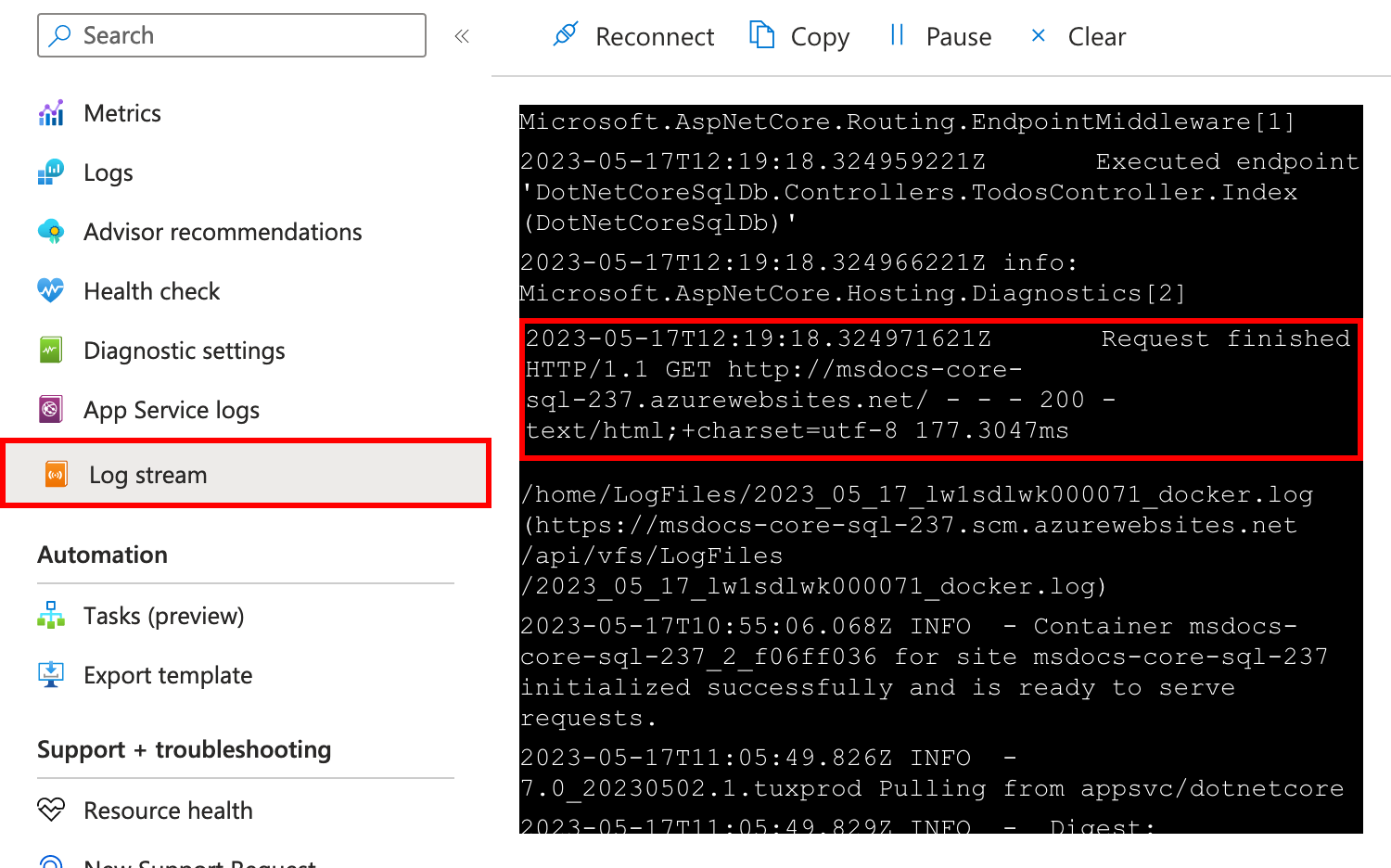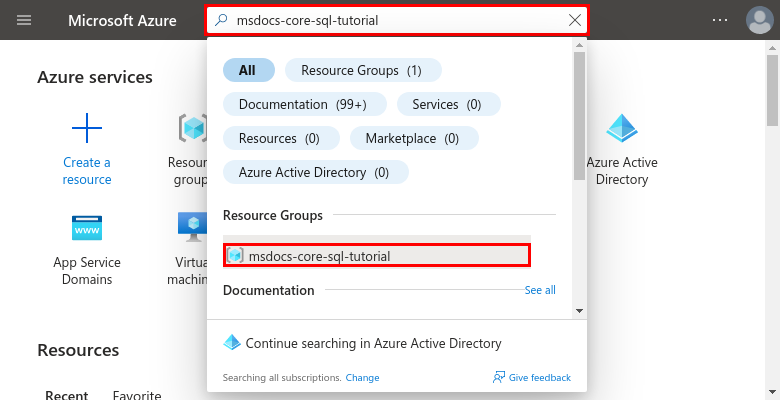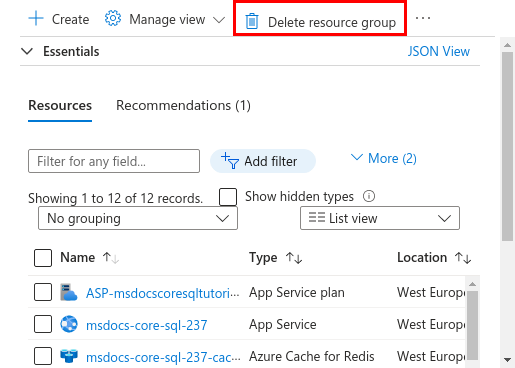Note
Access to this page requires authorization. You can try signing in or changing directories.
Access to this page requires authorization. You can try changing directories.
In this tutorial, you learn how to deploy a data-driven ASP.NET Core app to Azure App Service and connect to an Azure SQL Database. You'll also deploy an Azure Cache for Redis to enable the caching code in your application. Azure App Service is a highly scalable, self-patching, web-hosting service that can easily deploy apps on Windows or Linux. Although this tutorial uses an ASP.NET Core 8.0 app, the process is the same for other versions of ASP.NET Core.
In this tutorial, you learn how to:
- Create a secure-by-default App Service, SQL Database, and Redis cache architecture.
- Secure connection secrets using a managed identity and Key Vault references.
- Deploy a sample ASP.NET Core app to App Service from a GitHub repository.
- Access App Service connection strings and app settings in the application code.
- Make updates and redeploy the application code.
- Generate database schema by uploading a migrations bundle.
- Stream diagnostic logs from Azure.
- Manage the app in the Azure portal.
- Provision the same architecture and deploy by using Azure Developer CLI.
- Optimize your development workflow with GitHub Codespaces and GitHub Copilot.
Prerequisites
- An Azure account with an active subscription. If you don't have an Azure account, you can a trial subscription.
- A GitHub account. You can also get one for free.
- Knowledge of ASP.NET Core development.
- (Optional) To try GitHub Copilot, a GitHub Copilot account. A 30-day trial is available.
- An Azure account with an active subscription. If you don't have an Azure account, you can a trial subscription.
- Azure Developer CLI installed. You can follow the steps with the Azure Cloud Shell because it already has Azure Developer CLI installed.
- Knowledge of ASP.NET Core development.
- (Optional) To try GitHub Copilot, a GitHub Copilot account. A 30-day trial is available.
Skip to the end
If you just want to see the sample app in this tutorial running in Azure, just run the following commands in the Azure Cloud Shell, and follow the prompt:
dotnet tool install --global dotnet-ef
mkdir msdocs-app-service-sqldb-dotnetcore
cd msdocs-app-service-sqldb-dotnetcore
azd init --template msdocs-app-service-sqldb-dotnetcore
azd up
1. Run the sample
First, you set up a sample data-driven app as a starting point. For your convenience, the sample repository, includes a dev container configuration. The dev container has everything you need to develop an application, including the database, cache, and all environment variables needed by the sample application. The dev container can run in a GitHub codespace, which means you can run the sample on any computer with a web browser.
Step 1: In a new browser window:
- Sign in to your GitHub account.
- Navigate to https://github.com/Azure-Samples/msdocs-app-service-sqldb-dotnetcore/fork.
- Unselect Copy the main branch only. You want all the branches.
- Select Create fork.
Step 2: In the GitHub fork:
- Select main > starter-no-infra for the starter branch. This branch contains just the sample project and no Azure-related files or configuration.
- Select Code > Codespaces > Create codespace on starter-no-infra. The codespace takes a few minutes to set up.
Step 3: In the codespace terminal:
- Run database migrations with
dotnet ef database update. - Run the app with
dotnet run. - When you see the notification
Your application running on port 5093 is available., select Open in Browser. You should see the sample application in a new browser tab. To stop the application, typeCtrl+C.
Tip
You can ask GitHub Copilot about this repository. For example:
- @workspace What does this project do?
- @workspace What does the .devcontainer folder do?
Having issues? Check the Troubleshooting section.
2. Create App Service, database, and cache
In this step, you create the Azure resources. The steps used in this tutorial create a set of secure-by-default resources that include App Service, Azure SQL Database, and Azure Cache. For the creation process, you'll specify:
- The Name for the web app. It's used as part of the DNS name for your app.
- The Region to run the app physically in the world. It's also used as part of the DNS name for your app.
- The Runtime stack for the app. It's where you select the .NET version to use for your app.
- The Hosting plan for the app. It's the pricing tier that includes the set of features and scaling capacity for your app.
- The Resource Group for the app. A resource group lets you group (in a logical container) all the Azure resources needed for the application.
Sign in to the Azure portal and follow these steps to create your Azure App Service resources.
Step 1: In the Azure portal:
- In the top search bar, type app service.
- Select the item labeled App Service under the Services heading.
- Select Create > Web App. You can also navigate to the creation wizard directly.
Step 2: In the Create Web App page, fill out the form as follows.
- Name: msdocs-core-sql-XYZ. A resource group named msdocs-core-sql-XYZ_group will be generated for you.
- Runtime stack: .NET 8 (LTS).
- Operating System: Linux.
- Region: your preferred region.
- Linux Plan: Create new and use the name msdocs-core-sql-XYZ.
- Pricing plan: Basic B1. When you're ready, you can scale up to a different pricing tier.
Step 3:
- Select the Database tab.
- Select Create a Database.
- In Engine, select SQLAzure.
- Select Create an Azure Cache for Redis.
- In Name (under Cache), enter a name for the cache.
- In SKU, select Basic.
Step 4:
- Select the Deployment tab.
- Enable Continuous deployment.
- In Organization, select your GitHub alias.
- In Repository, select msdocs-app-service-sqldb-dotnetcore.
- In Branch, select starter-no-infra.
- Make sure Basic authentication is disabled.
- Select Review + create.
- After validation completes, select Create.
Step 5: The deployment takes a few minutes to complete. Once deployment completes, select the Go to resource button. You're taken directly to the App Service app, but the following resources are created:
- Resource group: The container for all the created resources.
- App Service plan: Defines the compute resources for App Service. A Linux plan in the Basic tier is created.
- App Service: Represents your app and runs in the App Service plan.
- Virtual network: Integrated with the App Service app and isolates back-end network traffic.
- Private endpoints: Access endpoints for the key vault, the database server, and the Redis cache in the virtual network.
- Network interfaces: Represents private IP addresses, one for each of the private endpoints.
- Azure SQL Database server: Accessible only from behind its private endpoint.
- Azure SQL Database: A database and a user are created for you on the server.
- Azure Cache for Redis: Accessible only from behind its private endpoint.
- Key vault: Accessible only from behind its private endpoint. Used to manage secrets for the App Service app.
- Private DNS zones: Enable DNS resolution of the key vault, the database server, and the Redis cache in the virtual network.
3. Secure connection secrets
The creation wizard generated the connectivity variable for you already as .NET connection strings and app settings. However, the security best practice is to keep secrets out of App Service completely. You'll move your secrets to a key vault and change your app setting to Key Vault references with the help of Service Connectors.
Tip
To use passwordless authentication, see How do I change the SQL Database connection to use a managed identity instead?
Step 1: Retrieve the existing connection string
- In the left menu of the App Service page, select Settings > Environment variables > Connection strings.
- Select AZURE_SQL_CONNECTIONSTRING.
- In Add/Edit connection string, in the Value field, find the Password= part at the end of the string.
- Copy the password string after Password= for use later. This connection string lets you connect to the SQL database secured behind a private endpoint. However, the secrets are saved directly in the App Service app, which isn't the best. Likewise, the Redis cache connection string in the App settings tab contains a secret. You'll change this.
Step 2: Create a key vault for secure management of secrets
- In the top search bar, type "key vault", then select Marketplace > Key Vault.
- In Resource Group, select msdocs-core-sql-XYZ_group.
- In Key vault name, type a name that consists of only letters and numbers.
- In Region, set it to the same location as the resource group.
Step 3: Secure the key vault with a Private Endpoint
- Select the Networking tab.
- Unselect Enable public access.
- Select Create a private endpoint.
- In Resource group, select msdocs-core-sql-XYZ_group.
- In the dialog, in Location, select the same location as your App Service app.
- In Name, type msdocs-core-sql-XYZVvaultEndpoint.
- In Location, select the same location as your App Service app.
- In Virtual network, select the virtual network in the msdocs-core-sql-XYZ_group group.
- In Subnet, select the available compatible subnet. The Web App wizard created it for your convenience.
- Select OK.
- Select Review + create, then select Create. Wait for the key vault deployment to finish. You should see "Your deployment is complete."
Step 4:
- In the top search bar, type msdocs-core-sql, then the App Service resource called msdocs-core-sql-XYZ.
- In the App Service page, in the left menu, select Settings > Service Connector. There are already two connectors, which the app creation wizard created for you.
- Select checkbox next to the SQL Database connector, then select Edit.
- Select the Authentication tab.
- In Password, paste the password you copied earlier.
- Select Store Secret in Key Vault.
- Under Key Vault Connection, select Create new. A Create connection dialog is opened on top of the edit dialog.
Step 5: Establish the Key Vault connection
- In the Create connection dialog for the Key Vault connection, in Key Vault, select the key vault you created earlier.
- Select Review + Create.
- When validation completes, select Create.
Step 6: Finalize the SQL Database connector settings
- You're back in the edit dialog for defaultConnector. In the Authentication tab, wait for the key vault connector to be created. When it's finished, the Key Vault Connection dropdown automatically selects it.
- Select Next: Networking.
- Select Configure firewall rules to enable access to target service. The app creation wizard already secured the SQL database with a private endpoint.
- Select Save. Wait until the Update succeeded notification appears.
Step 7: Configure the Redis connector to use Key Vault secrets
- In the Service Connector page, select the checkbox next to the Cache for Redis connector, then select Edit.
- Select the Authentication tab.
- Select Store Secret in Key Vault.
- Under Key Vault Connection, select the key vault you created.
- Select Next: Networking.
- Select Configure firewall rules to enable access to target service.
- Select Save. Wait until the Update succeeded notification appears.
Step 8: Verify the Key Vault integration
- From the left menu, select Settings > Environment variables > Connection strings again.
- Next to AZURE_SQL_CONNECTIONSTRING, select Show value. The value should be
@Microsoft.KeyVault(...), which means that it's a key vault reference because the secret is now managed in the key vault. - To verify the Redis connection string, select the App setting tab. Next to AZURE_REDIS_CONNECTIONSTRING, select Show value. The value should be
@Microsoft.KeyVault(...)too.
To summarize, the process for securing your connection secrets involved:
- Retrieving the connection secrets from the App Service app's environment variables.
- Creating a key vault.
- Creating a Key Vault connection with the system-assigned managed identity.
- Updating the service connectors to store the secrets in the key vault.
4. Deploy sample code
In this step, you configure GitHub deployment using GitHub Actions. It's just one of many ways to deploy to App Service, but also a great way to have continuous integration in your deployment process. By default, every git push to your GitHub repository kicks off the build and deploy action.
Step 1: Back in the GitHub codespace of your sample fork, run git pull origin starter-no-infra.
This pulls the newly committed workflow file into your codespace.
Step 2 (Option 1: with GitHub Copilot):
- Start a new chat session by selecting the Chat view, then selecting +.
- Ask, "@workspace How does the app connect to the database and the cache?" Copilot might give you some explanation about the
MyDatabaseContextclass and how it's configured in Program.cs. - Ask, "In production mode, I want the app to use the connection string called AZURE_SQL_CONNECTIONSTRING for the database and the app setting called AZURE_REDIS_CONNECTIONSTRING." Copilot might give you a code suggestion similar to the one in the Option 2: without GitHub Copilot steps below and even tell you to make the change in the Program.cs file.
- Open Program.cs in the explorer and add the code suggestion. GitHub Copilot doesn't give you the same response every time, and it's not always correct. You might need to ask more questions to fine-tune its response. For tips, see What can I do with GitHub Copilot in my codespace?.
Step 2 (Option 2: without GitHub Copilot):
- Open Program.cs in the explorer.
- Find the commented code (lines 12-21) and uncomment it.
This code connects to the database by using
AZURE_SQL_CONNECTIONSTRINGand connects to the Redis cache by using the app settingAZURE_REDIS_CONNECTIONSTRING.
Step 3 (Option 1: with GitHub Copilot):
- Open .github/workflows/starter-no-infra_msdocs-core-sql-XYZ in the explorer. This file was created by the App Service create wizard.
- Highlight the
dotnet publishstep and select .
. - Ask Copilot, "Install dotnet ef, then create a migrations bundle in the same output folder."
- If the suggestion is acceptable, select Accept. GitHub Copilot doesn't give you the same response every time, and it's not always correct. You might need to ask more questions to fine-tune its response. For tips, see What can I do with GitHub Copilot in my codespace?.
Step 3 (Option 2: without GitHub Copilot):
- Open .github/workflows/starter-no-infra_msdocs-core-sql-XYZ in the explorer. This file was created by the App Service create wizard.
- Under the
dotnet publishstep, add a step to install the Entity Framework Core tool with the commanddotnet tool install -g dotnet-ef --version 8.*. - Under the new step, add another step to generate a database migration bundle in the deployment package:
dotnet ef migrations bundle --runtime linux-x64 -o ${{env.DOTNET_ROOT}}/myapp/migrationsbundle. The migration bundle is a self-contained executable that you can run in the production environment without needing the .NET SDK. The App Service linux container only has the .NET runtime and not the .NET SDK.
Step 4:
- Select the Source Control extension.
- In the textbox, type a commit message like
Configure Azure database and cache connections. Or, select and let GitHub Copilot generate a commit message for you.
and let GitHub Copilot generate a commit message for you. - Select Commit, then confirm with Yes.
- Select Sync changes 1, then confirm with OK.
Step 5: Back in the Deployment Center page in the Azure portal:
- Select the Logs tab, then select Refresh to see the new deployment run.
- In the log item for the deployment run, select the Build/Deploy Logs entry with the latest timestamp.
Step 6: You're taken to your GitHub repository and see that the GitHub action is running. The workflow file defines two separate stages, build and deploy. Wait for the GitHub run to show a status of Success. It takes about 5 minutes.
Having issues? Check the Troubleshooting section.
5. Generate database schema
With the SQL Database protected by the virtual network, the easiest way to run dotnet database migrations is in an SSH session with the Linux container in App Service.
Step 1: Back in the App Service page, in the left menu,
- Select Development Tools > SSH.
- Select Go. (The start up takes a few minutes.)
Step 2: In the SSH session:
- Run
cd /home/site/wwwroot. Here are all your deployed files. - Run the migration bundle that the GitHub workflow generated, with the command
./migrationsbundle -- --environment Production. If it succeeds, App Service is connecting successfully to the SQL Database. Remember that--environment Productioncorresponds to the code changes you made in Program.cs.
In the SSH session, only changes to files in /home can persist beyond app restarts. Changes outside of /home aren't persisted.
Having issues? Check the Troubleshooting section.
6. Browse to the app
Step 1: In the App Service page:
- From the left menu, select Overview.
- Select the URL of your app.
Step 2: Add a few tasks to the list. Congratulations, you're running a web app in Azure App Service, with secure connectivity to Azure SQL Database.
Tip
The sample application implements the cache-aside pattern. When you visit a data view for the second time, or reload the same page after making data changes, Processing time in the webpage shows a much faster time because it's loading the data from the cache instead of the database.
7. Stream diagnostic logs
Azure App Service captures all console logs to help you diagnose issues with your application. The sample app includes logging code in each of its endpoints to demonstrate this capability.
Step 1: In the App Service page:
- From the left menu, select Monitoring > App Service logs.
- Under Application logging, select File System.
- In the top menu, select Save.
Step 2: From the left menu, select Log stream. You see the logs for your app, including platform logs and logs from inside the container.
8. Clean up resources
When you're finished, you can delete all of the resources from your Azure subscription by deleting the resource group.
Step 1: In the search bar at the top of the Azure portal:
- Enter the resource group name.
- Select the resource group.
Step 2: In the resource group page, select Delete resource group.
Step 3:
- Enter the resource group name to confirm your deletion.
- Select Delete.
2. Create Azure resources and deploy a sample app
In this step, you create the Azure resources and deploy a sample app to App Service on Linux. The steps used in this tutorial create a set of secure-by-default resources that include App Service, Azure SQL Database, and Azure Cache for Redis.
The dev container already has the Azure Developer CLI (AZD).
From the repository root, run
azd init.azd init --template dotnet-app-service-sqldb-infraWhen prompted, give the following answers:
Question Answer The current directory is not empty. Would you like to initialize a project here in '<your-directory>'? Y What would you like to do with these files? Keep my existing files unchanged Enter a new environment name Type a unique name. The AZD template uses this name as part of the DNS name of your web app in Azure ( <app-name>-<hash>.chinacloudsites.cn). Alphanumeric characters and hyphens are allowed.Sign into Azure by running the
azd auth logincommand and following the prompt:azd auth loginCreate the necessary Azure resources and deploy the app code with the
azd upcommand. Follow the prompt to select the desired subscription and location for the Azure resources.azd upThe
azd upcommand takes about 15 minutes to complete (the Redis cache takes the most time). It also compiles and deploys your application code, but you'll modify your code later to work with App Service. While it's running, the command provides messages about the provisioning and deployment process, including a link to the deployment in Azure. When it finishes, the command also displays a link to the deploy application.This AZD template contains files (azure.yaml and the infra directory) that generate a secure-by-default architecture with the following Azure resources:
- Resource group: The container for all the created resources.
- App Service plan: Defines the compute resources for App Service. A Linux plan in the Basic tier is created.
- App Service: Represents your app and runs in the App Service plan.
- Virtual network: Integrated with the App Service app and isolates back-end network traffic.
- Private endpoints: Access endpoints for the key vault, the database server, and the Redis cache in the virtual network.
- Network interfaces: Represents private IP addresses, one for each of the private endpoints.
- Azure SQL Database server: Accessible only from behind its private endpoint.
- Azure SQL Database: A database and a user are created for you on the server.
- Azure Cache for Redis: Accessible only from behind its private endpoint.
- Key vault: Accessible only from behind its private endpoint. Used to manage secrets for the App Service app.
- Private DNS zones: Enable DNS resolution of the key vault, the database server, and the Redis cache in the virtual network.
Once the command finishes creating resources and deploying the application code the first time, the deployed sample app doesn't work yet because you must make small changes to make it connect to the database in Azure.
Having issues? Check the Troubleshooting section.
3. Verify connection strings
Tip
The default SQL database connection string uses SQL authentication. For more secure, passwordless authentication, see How do I change the SQL Database connection to use a managed identity instead?
The AZD template you use generated the connectivity variables for you already as app settings and outputs the them to the terminal for your convenience. App settings are one way to keep connection secrets out of your code repository.
In the AZD output, find the settings
AZURE_SQL_CONNECTIONSTRINGandAZURE_REDIS_CONNECTIONSTRING. Only the setting names are displayed. They look like this in the AZD output:App Service app has the following connection strings: - AZURE_SQL_CONNECTIONSTRING - AZURE_REDIS_CONNECTIONSTRING - AZURE_KEYVAULT_RESOURCEENDPOINT - AZURE_KEYVAULT_SCOPEAZURE_SQL_CONNECTIONSTRINGcontains the connection string to the SQL Database in Azure, andAZURE_REDIS_CONNECTIONSTRINGcontains the connection string to the Azure Redis cache. You need to use them in your code later.For your convenience, the AZD template shows you the direct link to the app's app settings page. Find the link and open it in a new browser tab.
Having issues? Check the Troubleshooting section.
4. Modify sample code and redeploy
In the GitHub codespace, start a new chat session by selecting the Chat view, then selecting +.
Ask, "@workspace How does the app connect to the database and the cache?" Copilot might give you some explanation about the
MyDatabaseContextclass and how it's configured in Program.cs.Ask, "In production mode, I want the app to use the connection string called AZURE_SQL_CONNECTIONSTRING for the database and the app setting called AZURE_REDIS_CONNECTIONSTRING*." Copilot might give you a code suggestion similar to the one in the Option 2: without GitHub Copilot steps below and even tell you to make the change in the Program.cs file.
Open Program.cs in the explorer and add the code suggestion.
GitHub Copilot doesn't give you the same response every time, and it's not always correct. You might need to ask more questions to fine-tune its response. For tips, see What can I do with GitHub Copilot in my codespace?.
Before you deploy these changes, you still need to generate a migration bundle.
Having issues? Check the Troubleshooting section.
5. Generate database schema
With the SQL Database protected by the virtual network, the easiest way to run database migrations is in an SSH session with the App Service container. However, the App Service Linux containers don't have the .NET SDK, so the easiest way to run database migrations is to upload a self-contained migrations bundle.
Generate a migrations bundle for your project with the following command:
dotnet ef migrations bundle --runtime linux-x64 -o migrationsbundleTip
The sample application (see DotNetCoreSqlDb.csproj) is configured to include this migrationsbundle file. During the
azd packagestage, migrationsbundle will be added to the deploy package.Deploy all the changes with
azd up.azd upIn the AZD output, find the URL for the SSH session and navigate to it in the browser. It looks like this in the output:
Open SSH session to App Service container at: <URL>
In the SSH session, run the following commands:
cd /home/site/wwwroot ./migrationsbundle -- --environment ProductionIf it succeeds, App Service is connecting successfully to the database. Remember that
--environment Productioncorresponds to the code changes you made in Program.cs.Note
Only changes to files in
/homecan persist beyond app restarts. Changes outside of/homearen't persisted.
Having issues? Check the Troubleshooting section.
6. Browse to the app
In the AZD output, find the URL of your app and navigate to it in the browser. The URL looks like this in the AZD output:
Deploying services (azd deploy) (✓) Done: Deploying service web - Endpoint: <URL>
Add a few tasks to the list.
Congratulations, you're running a web app in Azure App Service, with secure connectivity to Azure SQL Database.
Having issues? Check the Troubleshooting section.
7. Stream diagnostic logs
Azure App Service can capture console logs to help you diagnose issues with your application. For convenience, the AZD template already enabled logging to the local file system and is shipping the logs to a Log Analytics workspace.
The sample application includes standard logging statements to demonstrate this capability, as shown in the following snippet:
public async Task<IActionResult> Index()
{
var todoItems = await _cache.GetAsync(_TodoItemsCacheKey);
if (todoItems != null)
{
_logger.LogInformation("Data from cache.");
var todoList = JsonConvert.DeserializeObject<List<Todo>>(Encoding.UTF8.GetString(todoItems));
return View(todoList);
}
else
{
_logger.LogInformation("Data from database.");
var todoList = await _context.Todo.ToListAsync();
var serializedTodoList = JsonConvert.SerializeObject(todoList);
await _cache.SetAsync(_TodoItemsCacheKey, Encoding.UTF8.GetBytes(serializedTodoList));
return View(todoList);
}
}
In the AZD output, find the link to stream App Service logs and navigate to it in the browser. The link looks like this in the AZD output:
Stream App Service logs at: <URL>
Learn more about logging in .NET apps in the series on Enable Azure Monitor OpenTelemetry for .NET, Node.js, Python and Java applications.
Having issues? Check the Troubleshooting section.
8. Clean up resources
To delete all Azure resources in the current deployment environment, run azd down and follow the prompts.
azd down
Troubleshooting
- The portal deployment view for Azure SQL Database shows a Conflict status
- In the Azure portal, the log stream UI for the web app shows network errors
- The SSH session in the browser shows
SSH CONN CLOSED - The portal log stream page shows
Connected!but no logs
The portal deployment view for Azure SQL Database shows a Conflict status
Depending on your subscription and the region you select, you might see the deployment status for Azure SQL Database to be Conflict, with the following message in Operation details:
Location '<region>' is not accepting creation of new Azure SQL Database servers at this time.
This error is most likely caused by a limit on your subscription for the region you select. Try choosing a different region for your deployment.
In the Azure portal, the log stream UI for the web app shows network errors
You might see this error:
Unable to open a connection to your app. This may be due to any network security groups or IP restriction rules that you have placed on your app. To use log streaming, please make sure you are able to access your app directly from your current network.
This is usually a transient error when the app is first started. Wait a few minutes and check again.
The SSH session in the browser shows SSH CONN CLOSED
It takes a few minutes for the Linux container to start up. Wait a few minutes and check again.
The portal log stream page shows Connected! but no logs
After you configure diagnostic logs, the app is restarted. You might need to refresh the page for the changes to take effect in the browser.
Frequently asked questions
- How much does this setup cost?
- How do I connect to the Azure SQL Database server that's secured behind the virtual network with other tools?
- How does local app development work with GitHub Actions?
- How do I debug errors during the GitHub Actions deployment?
- How do I change the SQL Database connection to use a managed identity instead?
- I don't have permissions to create a user-assigned identity
- What can I do with GitHub Copilot in my codespace?
How much does this setup cost?
Pricing for the created resources is as follows:
- The App Service plan is created in Basic tier and can be scaled up or down. See App Service pricing.
- The Azure SQL Database is created in general-purpose, serverless tier on Standard-series hardware with the minimum cores. There's a small cost and can be distributed to other regions. You can minimize cost even more by reducing its maximum size, or you can scale it up by adjusting the serving tier, compute tier, hardware configuration, number of cores, database size, and zone redundancy. See Azure SQL Database pricing.
- The Azure Cache for Redis is created in Basic tier with the minimum cache size. There's a small cost associated with this tier. You can scale it up to higher performance tiers for higher availability, clustering, and other features. See Azure Cache for Redis pricing.
- The virtual network doesn't incur a charge unless you configure extra functionality, such as peering. See Azure Virtual Network pricing.
- The private DNS zone incurs a small charge. See Azure DNS pricing.
How do I connect to the Azure SQL Database server that's secured behind the virtual network with other tools?
- For basic access from a command-line tool, you can run
sqlcmdfrom the app's SSH terminal. The app's container doesn't come withsqlcmd, so you must install it manually. Remember that the installed client doesn't persist across app restarts. - To connect from a SQL Server Management Studio client or from Visual Studio, your machine must be within the virtual network. For example, it could be an Azure VM that's connected to one of the subnets, or a machine in an on-premises network that has a site-to-site VPN connection with the Azure virtual network.
How does local app development work with GitHub Actions?
Take the autogenerated workflow file from App Service as an example, each git push kicks off a new build and deployment run. From a local clone of the GitHub repository, you make the desired updates push it to GitHub. For example:
git add .
git commit -m "<some-message>"
git push origin main
How do I debug errors during the GitHub Actions deployment?
If a step fails in the autogenerated GitHub workflow file, try modifying the failed command to generate more verbose output. For example, you can get more output from any of the dotnet commands by adding the -v option. Commit and push your changes to trigger another deployment to App Service.
I don't have permissions to create a user-assigned identity
See Set up GitHub Actions deployment from the Deployment Center.
How do I change the SQL Database connection to use a managed identity instead?
The default connection string to the SQL database is managed by Service Connector, with the name defaultConnector, and it uses SQL authentication. To replace it with a connection that uses a managed identity, run the following commands in the cloud shell after replacing the placeholders:
az extension add --name serviceconnector-passwordless --upgrade
az sql server update --enable-public-network true
az webapp connection delete sql --connection defaultConnector --resource-group <group-name> --name <app-name>
az webapp connection create sql --connection defaultConnector --resource-group <group-name> --name <app-name> --target-resource-group <group-name> --server <database-server-name> --database <database-name> --client-type dotnet --system-identity --config-connstr true
az sql server update --enable-public-network false
By default, the command az webapp connection create sql --client-type dotnet --system-identity --config-connstr does the following:
- Sets your user as the Microsoft Entra ID administrator of the SQL database server.
- Create a system-assigned managed identity and grants it access to the database.
- Generates a passwordless connection string called
AZURE_SQL_CONNECTIONGSTRING, which your app is already using at the end of the tutorial.
Your app should now have connectivity to the SQL database. For more information, see Tutorial: Connect to Azure databases from App Service without secrets using a managed identity.
Tip
Don't want to enable public network connection? You can skip az sql server update --enable-public-network true by running the commands from an Azure cli that's integrated with your virtual network if you have the Owner role assignment on your subscription.
To grant the identity the required access to the database that's secured by the virtual network, az webapp connection create sql needs direct connectivity with Entra ID authentication to the database server. By default, the Azure cloud shell doesn't have this access to the network-secured database.
What can I do with GitHub Copilot in my codespace?
You might have noticed that the GitHub Copilot chat view was already there for you when you created the codespace. For your convenience, we include the GitHub Copilot chat extension in the container definition (see .devcontainer/devcontainer.json). However, you need a GitHub Copilot account (30-day trial available).
A few tips for you when you talk to GitHub Copilot:
- In a single chat session, the questions and answers build on each other and you can adjust your questions to fine-tune the answer you get.
- By default, GitHub Copilot doesn't have access to any file in your repository. To ask questions about a file, open the file in the editor first.
- To let GitHub Copilot have access to all of the files in the repository when preparing its answers, begin your question with
@workspace. For more information, see Use the @workspace agent. - In the chat session, GitHub Copilot can suggest changes and (with
@workspace) even where to make the changes, but it's not allowed to make the changes for you. It's up to you to add the suggested changes and test it.
Here are some other things you can say to fine-tune the answer you get:
- I want this code to run only in production mode.
- I want this code to run only in Azure App Service and not locally.
- The --output-path parameter seems to be unsupported.
Related content
Advance to the next tutorial to learn how to secure your app with a custom domain and certificate.
Or, check out other resources:
